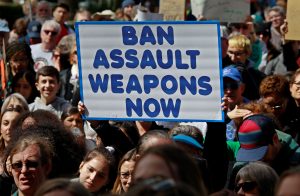
By Steve Holland and Phil Stewart
WASHINGTON (Reuters) – U.S., British and French forces pounded Syria with air strikes early on Saturday in response to a poison gas attack that killed dozens of people last week, in the biggest intervention by Western powers against Syrian President Bashar al-Assad.
U.S. President Donald Trump announced the military action from the White House late on Friday. As he spoke, explosions rocked Damascus. British Prime Minister Theresa May and French President Emmanuel Macron said the UK and France had joined in the attack.
Trump said he was prepared to sustain the response until Assad’s government stopped its use of chemical weapons.
The strikes were the biggest intervention by Western powers against Assad in the country’s seven-year-old civil war and pitted the United States and its allies against Russia, which itself intervened in the war in 2015 to back Assad.
“A short time ago, I ordered the United States Armed Forces to launch precision strikes on targets associated with the chemical weapons capabilities of Syrian dictator Bashar al-Assad,” Trump said in a televised address from the White House.
Speaking of Assad and his suspected role in last week’s chemical weapons attack, Trump said, “These are not the actions of a man. They are crimes of a monster instead.”
A U.S. official told Reuters the strikes were aimed at multiple targets and involved Tomahawk cruise missiles.
At least six loud explosions were heard in Damascus in the early hours of Saturday and smoke was seen rising over the Syrian capital, a Reuters witness said. A second witness said the Barzah district of Damascus had been hit in the strikes. Barzah is the location of a major Syrian scientific research center.
At a Pentagon briefing, the Chairman of the Joint Chiefs of Staff General Joseph Dunford said the targets included a Syrian research facility and a chemical weapons storage facility.
A second U.S. official said targets were being carefully selected with the aim of damaging Assad’s ability to conduct further gas attacks, while avoiding the risk of spreading poisonous fallout in civilian areas.
“The purpose of our actions tonight is to establish a strong deterrent against the production, spread and use of chemical weapons,” Trump said.
The U.S. president, who has tried to build good relations with Russian President Vladimir Putin, had sharply critical words for both Russia and Iran, which have backed Assad’s government.
“To Iran and to Russia, I ask, what kind of a nation wants to be associated with the mass murder of innocent men, women and children?” Trump said.
British Prime Minister Theresa May said she had authorized British armed forces “to conduct coordinated and targeted strikes to degrade the Syrian regime’s chemical weapons capability.” She described it as a “limited and targeted strike” aimed at minimizing civilian casualties.
The military action is not about intervening in Syria’s civil war or changing its government, she said.
It was not immediately clear how extensive the strikes were. U.S. officials had earlier said that Trump had pressed for a more aggressive U.S. strike against Syria than his military chiefs had recommended.
U.S. Defense Secretary Jim Matt and other military leaders had warned that the larger the attack, the greater the risk of a confrontation with Russia, two U.S. officials said.
Trump made clear in his eight-minute television address that he is wary of a deeper entanglement in Syria, where about 2,000 U.S. troops have been deployed to fight Islamic State.
“America does not seek an indefinite presence in Syria,” he said.
The air strikes, however, risk dragging the United States further into Syria’s civil war, particularly if Russia, Iran and Ass opt to retaliate.
(Reporting by Steve Holland, Tim Ahmann, Eric Beech, Lesley Wroughton in Washington D.C.; Additional reporting by Samia Nakhoul and Tom Perry in Beirut, Michael Holden and Guy Faulconbridge in London, and Jean-Baptiste Vey, Geert de Clerq and Matthias Blamont in Paris; Writing by Yara Bayoumy and Warren Strobel; Editing by Clive McKeef)










